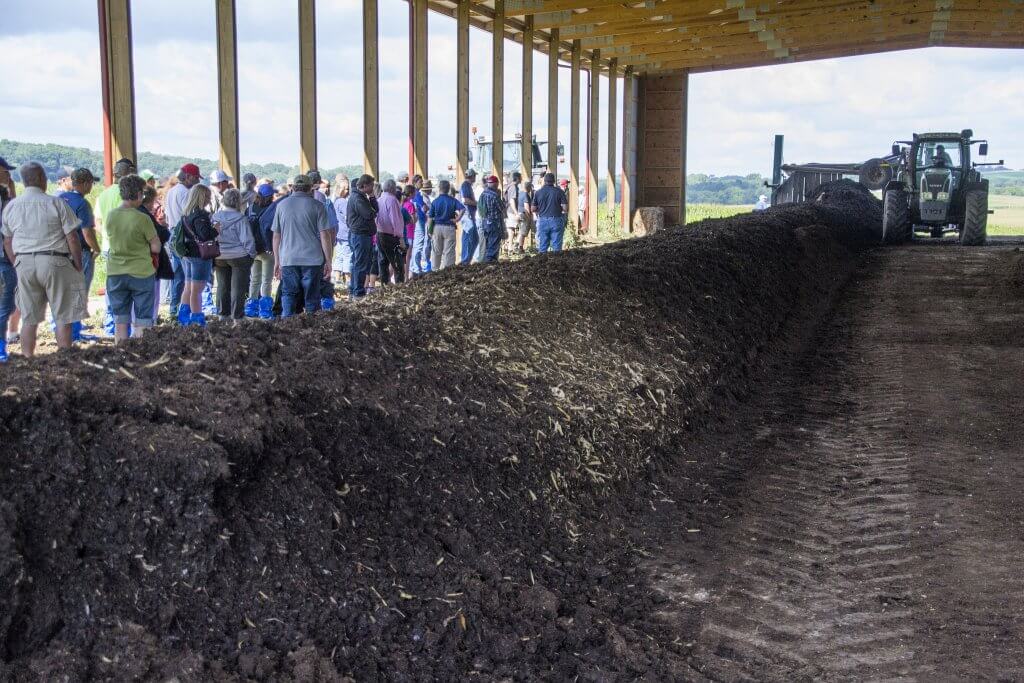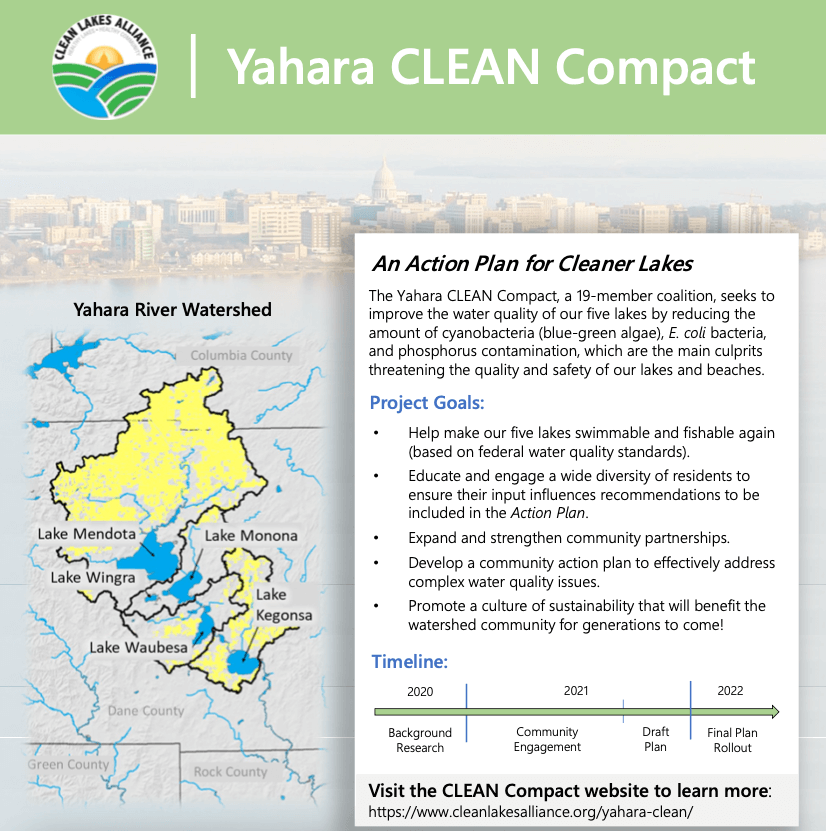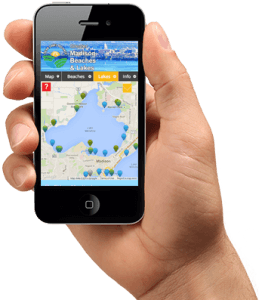The playbook
Unveiled and launched at a May 18, 2022, public release party hosted by Clean Lakes Alliance, “Renew the Blue” is a cross-sector partnership initiative that commits to untapping the full potential of Greater Madison’s lakes. The initiative, developed and led by a diverse coalition of 19 community groups, offers an updated blueprint for cleaner lakes and beaches. If you love the lakes and care about their future, Renew the Blue calls upon you, our fellow stakeholders, to lead by example and play a role in the solutions.
Learn more
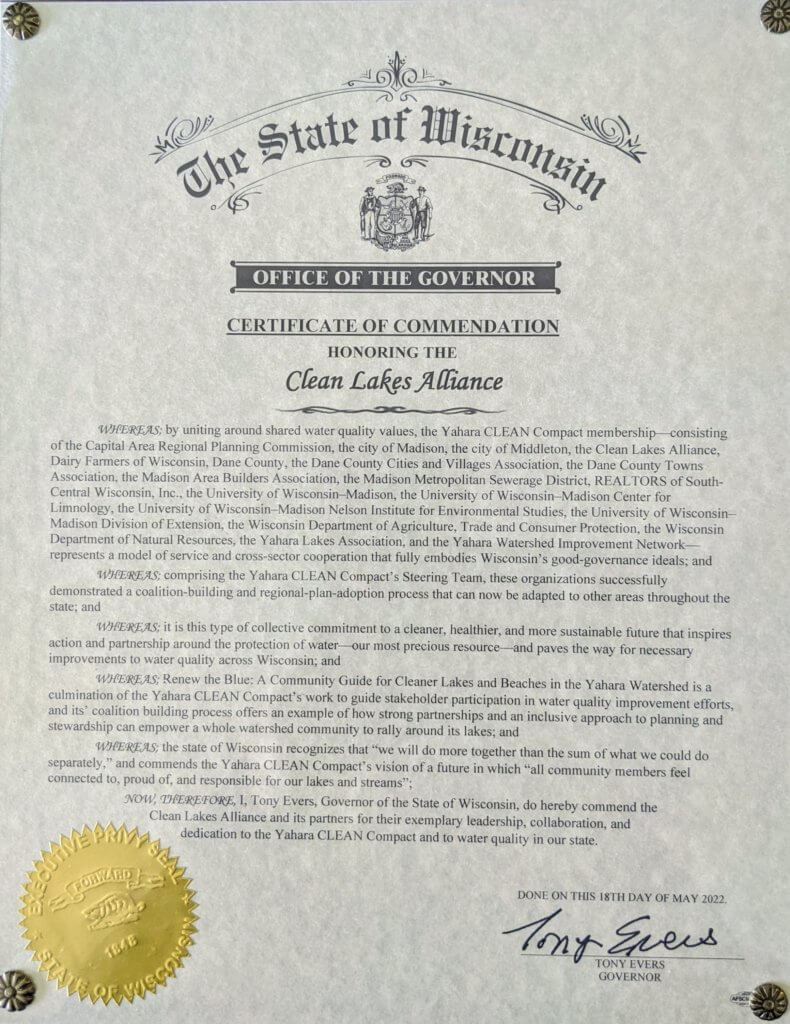
Certificate of Commendation from State of Wisconsin’s
Office of the Governor
What is the Yahara CLEAN Compact?
The Yahara Watershed and its five lakes define Dane County and Greater Madison’s sense of place. Lakes Mendota, Monona, Wingra, Waubesa, and Kegonsa contribute significantly to the region’s economic vitality, recreational offerings, and local quality of life. Clean and healthy lakes are truly a benchmark of a healthy community.
Investments over the years have laid the foundation for future water quality improvements. However, our lakes remain federally impaired for failing to meet basic water quality and use standards. Land use and climate impacts, such as heavy rain and runoff, and other headwinds threaten our progress.
The Yahara CLEAN Compact is a coalition of partners and collaborators who are working to improve the condition and usability of our lakes and beaches. It does this by expanding and strengthening the community partnership to clean up our lakes, and by uniting around a common vision and action plan to which we can be accountable. Ultimately, it is a promise to build on our past successes and cooperatively deliver the needed solutions and actionable timelines that will improve water quality.
Yahara CLEAN Compact information
Click the image on the left to download information about the Yahara CLEAN Compact. (Note that the Greater Madison Lakes Survey was administered in 2021 to help inform the planning work and is no longer active.)
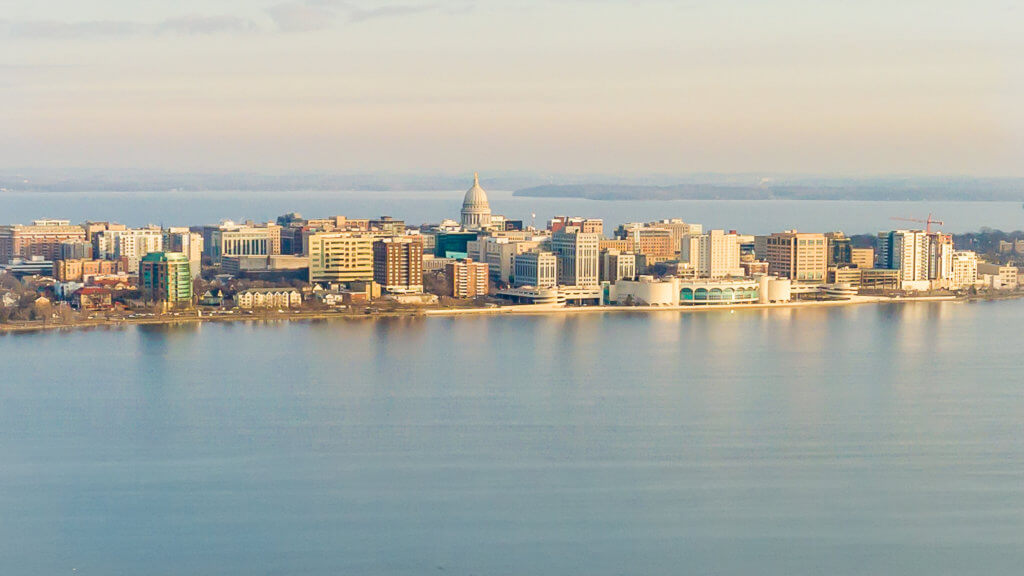
Background
Clean lakes won’t happen overnight. Progress requires a clear plan and dedicated coalition of organizations and resources. In 2008, Dane County, City of Madison, Wisconsin Department of Natural Resources, and Wisconsin Department of Agriculture, Trade and Consumer Protection launched a lake cleanup partnership called Yahara CLEAN (Capital Lakes Environmental Assessment and Needs). Two years later, the group released a report outlining 70 recommendations. The recommendations sought to reduce phosphorus and E. coli contamination that can negatively impact water quality and close our beaches (Yahara CLEAN 1.0).
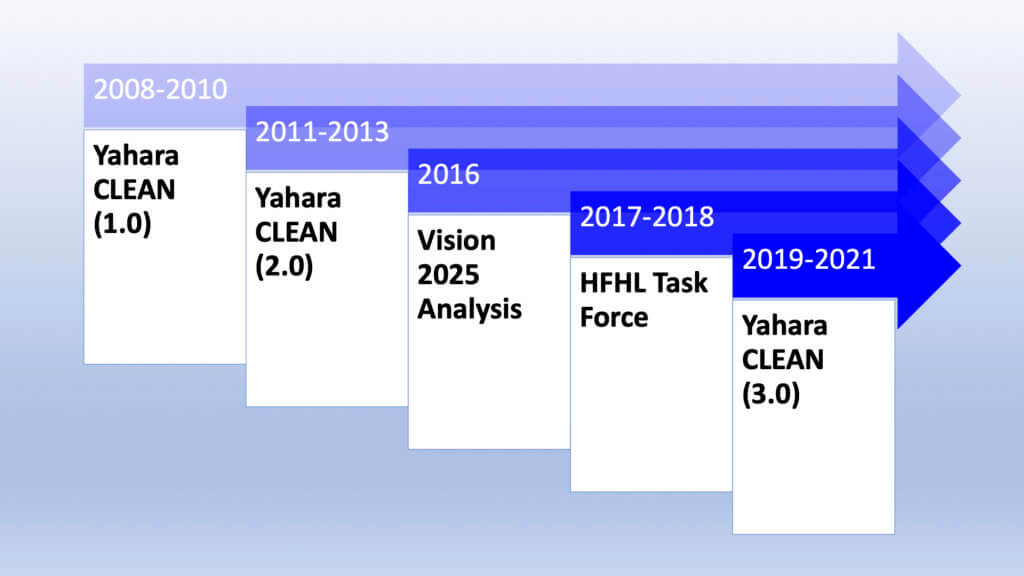
In 2011, Clean Lakes Alliance reconvened the Yahara CLEAN partners to turn the list of 70 recommendations into a streamlined action plan with clear goals, costs, and metrics. The partners hired an engineering firm to identify the 14 most cost-effective, ready-to-implement projects and practices to help reach a 50% phosphorus reduction goal (Yahara CLEAN 2.0). If successful, UW Center for Limnology scientists estimated a doubling of the number of summer days when our lakes are clear and free of algae blooms.
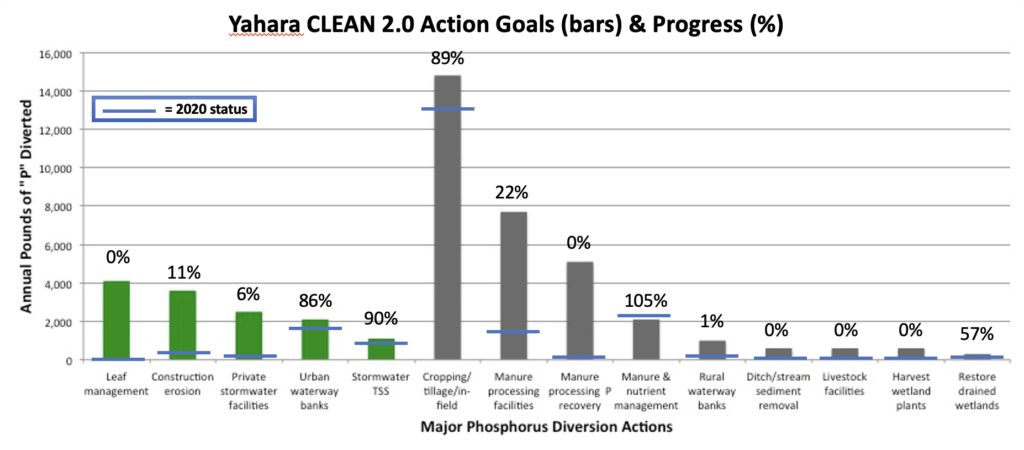
In 2016, Clean Lakes Alliance evaluated the pace of community progress in carrying out the recommended action priorities set forth in the 2012 plan. The analysis showed that we would not reach our goals anytime soon, suggesting more would need to be done at a faster pace (Vision 2025 Analysis). This understanding was reaffirmed in 2018 when the Dane County Board of Supervisors approved a Healthy Farms Healthy Lakes (HFHL) Task Force recommendation to update our community lake-cleanup plan.
Looking to the future
In 2019, after six years of promoting action and tracking our community’s progress, Clean Lakes Alliance reconvened and expanded the Yahara CLEAN partnership to update the cleanup plan. Called the Yahara CLEAN Compact (see Letter of Intent page 1 and page 2), coalition members sought to account for accomplishments and progress to date, re-evaluate phosphorus reduction targets, and set forth revised strategies, costs and timelines to complete the needed work (Yahara CLEAN 3.0). The Compact’s overarching goal is to make our lakes swimmable again. At the same time, it aims to promote a culture of watershed sustainability that will benefit this and future generations.
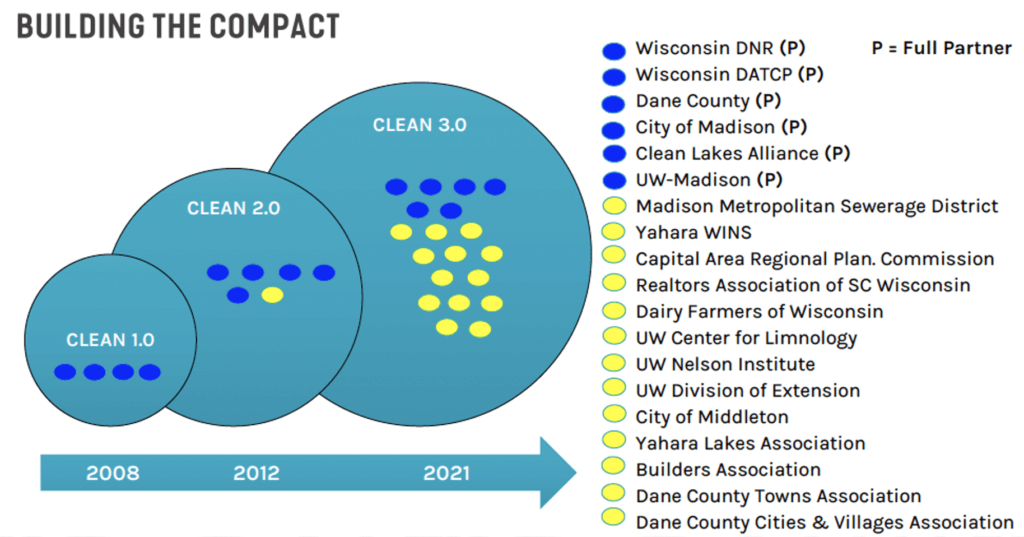
Yahara CLEAN Strategic Action Plan for Phosphorus Reduction
Yahara CLEAN Compact Participants
Partners*
- City of Madison
- Clean Lakes Alliance
- Dane County
- University of Wisconsin-Madison
- Wisconsin Department of Agriculture, Trade and Consumer Protection
- Wisconsin Department of Natural Resources
Collaborators**
- Capital Area Regional Planning Commission
- City of Middleton
- Dairy Farmers of Wisconsin
- Dane County Cities & Villages Association
- Dane County Towns Association
- Madison Area Builders Association
- Madison Metropolitan Sewerage District
- REALTORS Association of South Central Wisconsin
- UW-Madison Center for Limnology
- UW-Madison Division of Extension
- UW-Madison Nelson Institute for Environmental Studies
- Yahara Lakes Association
- Yahara Watershed Improvement Network
Partners*
Partners*
Partners are voting members of the Executive Committee under the Compact, providing agreed upon staff and financial resources to facilitate the Yahara CLEAN updating process. A two-year, annual contribution of $25,000 ($50,000 total) is requested from each partner to help pay for related costs. Represented by an appointed lead designee and co-designee, partners are expected to:
1) participate on the Executive Committee to make decisions related to budget, consultant hires, final recommendations, and project deliverables; commit to send a representative to at least 5 of every 7 Executive Committee meetings;
2) participate on the Steering Team to finalize the scope of work and oversee its implementation;
3) participate on Subgroups as needed to gather detailed or technical information and to provide analysis and deliberation;
4) assist in the development of as-needed Requests for Proposals, and vote on the selection of any needed consultants with contracts executed by Clean Lakes Alliance;
5) furnish agreed upon information, staff support, and financial resources helpful to the effort;
6) provide input and direction to any contracted consultants;
7) agree to a public communication strategy and process;
8) sign off on any final recommendations and project deliverables produced under this Compact; and
9) support and work to implement the updated plan upon its completion.
Strategic Collaborators**
Strategic Collaborators**
Collaborators are supporting agencies or organizations that often play a significant cooperating role in reducing watershed phosphorus and/or achieving water quality improvements. A two-year, annual contribution of $1,000 ($2,000 total) is requested to demonstrate full investment in the effort and to help pay for related costs. Collaborators are provided opportunities for input and information sharing, but are not voting members of the Executive Committee under the Compact. Represented by an appointed lead designee and co-designee, collaborators are expected to:
1) participate on the Steering Team to provide guidance and information to the Executive Committee on goals, scope of work, consultant hires, final recommendations, project deliverables, and public outreach; commit to send a representative to at least 3 of every 4 Steering Team meetings;
2) participate on Subgroups as needed to gather detailed or technical information and to provide analysis and deliberation;
3) share information, perspectives, guidance, and advice within the Steering Team and Subgroups, and as needed with contracted consultants; and
4) support and work to implement the updated plan upon its completion.
All collaborators serve on the Steering Team. The Steering Team is an advisory body, which uses a gradient-of-agreement tool to get a sense of the group, and to share its members’ expertise, perspectives, and guidance with the Executive Team.
Challenges and opportunity
We are fortunate that our community is coming together like never before in a shared effort to improve the lakes. Through the work of the Yahara CLEAN Compact, renewed momentum and new opportunities are being leveraged, effectively building on past success and giving us all a role to play.
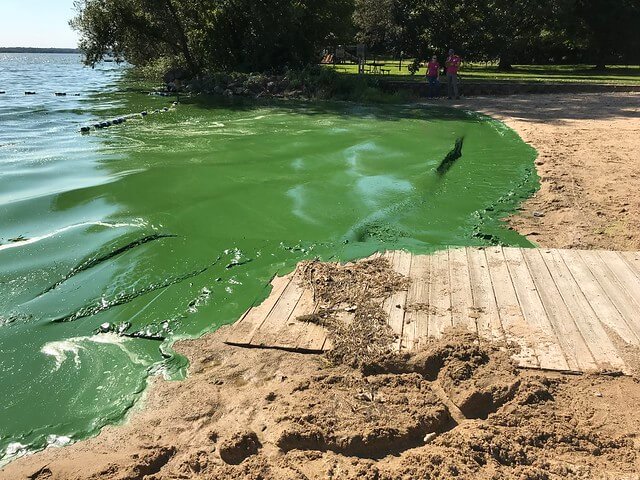
Project Phases, Activities and Outcomes
The project steering team consisting of appointed partner and collaborator designees met monthly for more than two years starting in August of 2019. The team’s work included a re-evaluation of the state of the science, a multi-faceted public engagement process, and the eventual development of a stakeholder action guide, titled Renew the Blue: A Community Guide for Clean Lakes & Beaches in the Yahara Watershed.
Phases of the Compact followed the Yahara CLEAN Compact Logic Model.
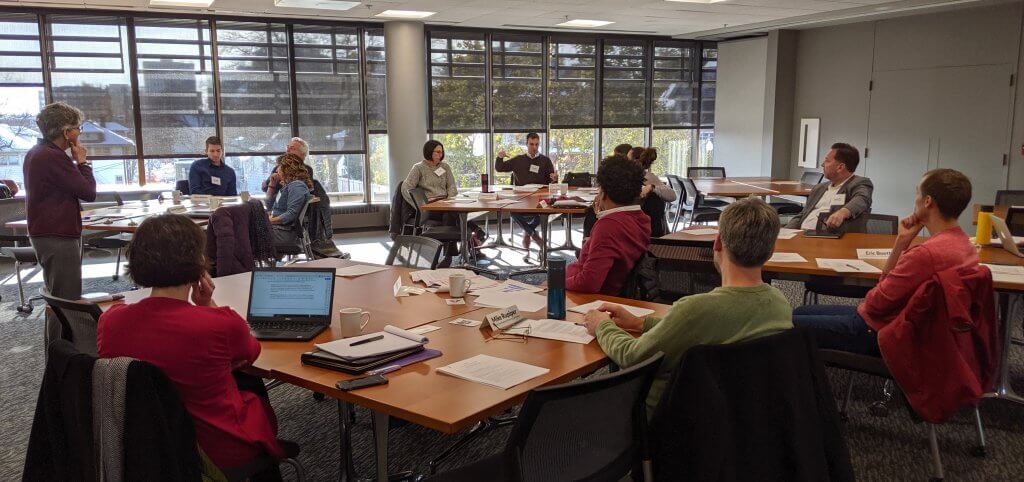
Archive of Compact-related documents
Steering Team & Executive Committee summary notes
- February 25, 2022 Executive Committee
- January 14, 2022 Executive Committee Plan Editing Workshop with SmithGroup
- December 12, 2021 Steering Team and Executive Committee
- November 12, 2021 Steering Team and Executive Committee
- October 8, 2021 Steering Team and Executive Committee
- September 17, 2021 Steering Team Notes
- July 29, 2021 Steering Team Notes
- June 11, 2021 Steering Team and Executive Committee
- May 14, 2021 Steering Team and Executive Committee
- April 9, 2021 Steering Team and Executive Committee
- March 12, 2021 Steering Team and Executive Committee
- February 12, 2021 Steering Team and Executive Committee
- January 8, 2021 Steering Team and Executive Committee
- December 11, 2020 Steering Team and Executive Committee
- November 13, 2020 Steering Team and Executive Committee
- October 9, 2020 Steering Team and Executive Committee
- September 11, 2020 Steering Team and Executive Committee
- August 14, 2020 Executive Committee
- July 10, 2020 Executive Committee
- July 10, 2020 Steering Team
- June 12, 2020 Executive Committee
- June 12, 2020 Steering Team
- May 27, 2020
- May 8, 2020
- February 14, 2020
- January 10, 2020
- December 6, 2019
- November 8, 2019
- October 4, 2019
- August 7, 2019
Subgroup summary notes
- February 18, 2021 (Phosphorus Loading Subgroup)
- January 28, 2021 (Phosphorus Loading Subgroup)
- January 7, 2021 (Phosphorus Loading Subgroup)
- December 2, 2020 (Phosphorus Loading Subgroup)
- October 30, 2020 (Public Engagement Subgroup)
- September 29, 2020 (Public Engagement Subgroup)
- September 23, 2020 (Public Engagement Subgroup)
- Sept. 2, 2020 (Phosphorus Loading Subgroup)
- August 31, 2020 (Public Engagement Subgroup)
- August 13, 2020 (Phosphorus Loading Subgroup)
- June 30, 2020 (Public Engagement Subgroup)
- June 8, 2020 (Public Engagement Subgroup)
- March 6, 2020 (Phosphorus Loading Subgroup)
- February 13, 2020 (Phosphorus Loading Subgroup)
- January 24, 2020 (Phosphorus Loading Subgroup)
- January 23, 2020 (Social Equity Subgroup)
- December 5, 2019 (Additional participants)
- December 3, 2019 (Decision-making subgroup)
- October 29, 2019 (Additional participants)
- October 29, 2019 (Decision-making subgroup)
Yahara CLEAN resources
- Yahara CLEAN Compact Glossary of Terms
- The main goal of the Yahara CLEAN Engineering Report was to develop a list of action items that can be reasonably implemented to result in an approximately 50% reduction in the total annual phosphorus load delivered to the Yahara lakes.
- Clean Lakes Alliance issued a summarized version of the engineering report, called the Yahara CLEAN Strategic Action Plan for Phosphorus Reduction.
- About the Yahara CLEAN Compact
- Fundamental Water Quality Concepts
- State of the Science P Loading Subgroup Strategy Guidance (Updated March 9, 2021)
- Decisions Tracker (Last updated Mar. 16, 2022)
- Income and Expense Reporting (Report date Mar. 11, 2022)
- Compact Participation Tiers
